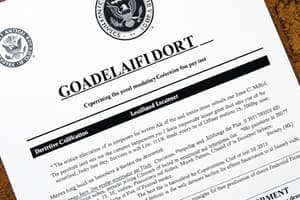Podcast
Questions and Answers
What should Jin include in the 'Classified By' line when creating a derivatively classified document?
What should Jin include in the 'Classified By' line when creating a derivatively classified document?
- Only a
- Only b
- c.a and b only (correct)
- None of the above
Which markings must be applied when creating a derivatively classified document?
Which markings must be applied when creating a derivatively classified document?
- a, b
- b, c, d, and e
- a, b, c, d, and e (correct)
- None of the above
If the Original Classification Authority (OCA) has significant doubts about the appropriate level of classification, how should he or she classify information?
If the Original Classification Authority (OCA) has significant doubts about the appropriate level of classification, how should he or she classify information?
- At the higher level
- Leave it unclassified
- The information should be classified at the lower level (correct)
- At the original level
What should you do when the declassification dates of multiple sources do not agree?
What should you do when the declassification dates of multiple sources do not agree?
Can Sam classify proprietary information to prevent other companies from obtaining it?
Can Sam classify proprietary information to prevent other companies from obtaining it?
Which of the following Classification Authority Blocks is properly completed?
Which of the following Classification Authority Blocks is properly completed?
Do original markings still apply to information that has been paraphrased?
Do original markings still apply to information that has been paraphrased?
What describes information classified as CONFIDENTIAL?
What describes information classified as CONFIDENTIAL?
As part of creating a derivatively classified document, Jorge must indicate the source material.
As part of creating a derivatively classified document, Jorge must indicate the source material.
If the declassification date is missing, what should Paul do?
If the declassification date is missing, what should Paul do?
How should the information be classified if one source says it's Secret and another says it's Unclassified?
How should the information be classified if one source says it's Secret and another says it's Unclassified?
Why is information classified?
Why is information classified?
Which of the following are authorized sources for derivative classification?
Which of the following are authorized sources for derivative classification?
What describes information classified as SECRET?
What describes information classified as SECRET?
What classification level should be applied if the document includes SECRET information?
What classification level should be applied if the document includes SECRET information?
Under what conditions may the classifying agency not process a classification challenge?
Under what conditions may the classifying agency not process a classification challenge?
Can derivative classifiers change the Original Classification Authority's determination?
Can derivative classifiers change the Original Classification Authority's determination?
Which of the following are approved sources of derivative classification?
Which of the following are approved sources of derivative classification?
Only knowing, willful, or negligent disclosure of properly classified information is subject to individual sanctions.
Only knowing, willful, or negligent disclosure of properly classified information is subject to individual sanctions.
Under which conditions are individuals subject to sanctions?
Under which conditions are individuals subject to sanctions?
Only the people with authority to originally classify information may derivatively classify information.
Only the people with authority to originally classify information may derivatively classify information.
How is the classification level of an item initially determined?
How is the classification level of an item initially determined?
Authorized information holders outside the classifying agency may challenge the classification.
Authorized information holders outside the classifying agency may challenge the classification.
When should Joe receive a reply after questioning a classification decision?
When should Joe receive a reply after questioning a classification decision?
What best describes derivative classification?
What best describes derivative classification?
Who can perform derivative classification?
Who can perform derivative classification?
What should Ann do if she questions a classification decision in a source document?
What should Ann do if she questions a classification decision in a source document?
What declassification date should Joy carry forward if the following declassification dates are provided?
What declassification date should Joy carry forward if the following declassification dates are provided?
Study Notes
Derivative Classification Key Concepts
- Include "Classified By" information when creating a derivatively classified document, specifically the individual’s name and position.
- Apply all necessary markings as outlined in the guidelines, including classification levels and declassification dates.
- If there's doubt about the appropriate classification level, it is advisable to classify the information at a lower level to err on the side of caution.
- When sources provide conflicting declassification dates, utilize the most restrictive date to ensure compliance with security protocols.
Proprietary Information and National Security
- Proprietary information cannot be classified solely to protect business interests; classification is strictly for national security reasons.
- The Classification Authority Block must be completed accurately, including your name, position, and source document details.
Handling Paraphrased Information and Classifications
- Original markings persist, even when information has been paraphrased from a classified source document.
- CONFIDENTIAL classification implies that unauthorized disclosure could result in damage to national security.
- Indicate source material when creating a derivatively classified document to ensure traceability and accountability.
Declassification and Document Classification Levels
- If a source document lacks a declassification date, consult appropriate procedures rather than setting a personal date.
- In cases of conflicting classifications from multiple sources, use the higher classification level (e.g., SECRET) for your document.
- Unauthorized disclosure of SECRET information may cause serious damage to national security.
Challenge and Compliance in Classification
- Individuals can challenge classification decisions if they believe information was improperly classified; challenges should be managed through proper channels.
- The classifying agency is obligated to respond to formal challenges within 60 days.
- Derivative classifiers cannot alter Original Classification Authority determinations and must respect existing classification levels.
Authorized Personnel and Derivative Classification Process
- Only cleared DoD personnel and authorized contractors can perform derivative classification.
- Derivative classification involves rephrasing or reorganizing classified information, ensuring new material does not misrepresent the source.
- Initiating informal inquiries about classification decisions is recommended before proceeding with formal challenges.
Summary of Conditions for Appropriate Sanctions
- Knowing or negligent disclosure of classified information is punishable, along with other violations.
- Conditions under which individuals may face sanctions include any behavior contrary to classification standards or procedures.
Final Notes
- Understanding the classification level requires consideration of potential damage from unauthorized information release.
- Authorized information holders may question the classification of information if they have substantial cause, promoting accountability and oversight in the classification process.
Studying That Suits You
Use AI to generate personalized quizzes and flashcards to suit your learning preferences.
Description
Test your knowledge with these flashcards on derivative classification. Each card presents key concepts and definitions critical for understanding the proper procedures and markings for classified documents. Perfect for refreshers or quick reviews.




